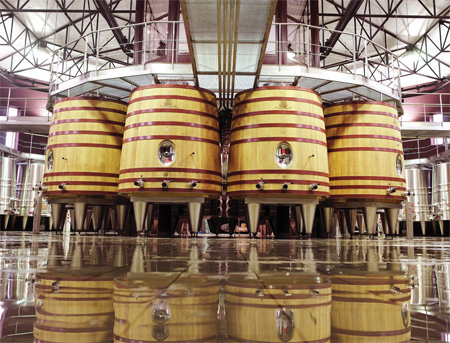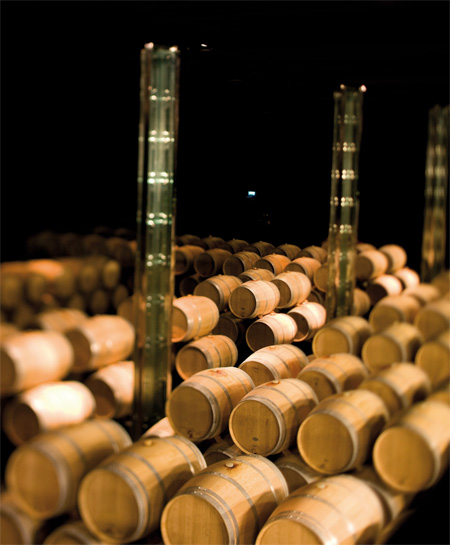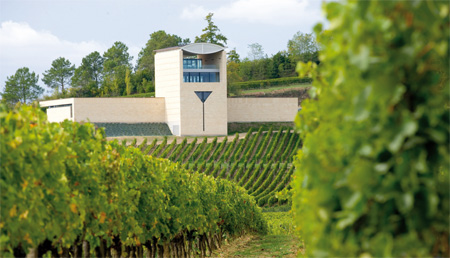France Bordelais
Brand new and very beautiful wine storehousesIs the small oak barrel the best destiny which a high-class wine can know?
The rise of new wine storehouses on the French terroirs makes it imaginable.

Cuvier du Château Malartic-Lagravière

Le chai du Château Lafite Rothschild conçu par Ricardo Bofill

La cuverie de Cos d’Estournel
In 2008, Cos d' Estournel, major property of the Medoc, temple dedicated to the wine turned towards the East and avant-gardism by its founder, inaugurated a new vat house made of glass and steel, as well as an underground cellar arranged with modernity and technicality by Jean-Michel Wilmotte. Obviously Cos d'Estournel used the gravitating system, from the picking until the bottling, a new initiative for a vineyard of such a surface area: 91 hectares! The grapes, brought to a sorting table by a system of assembled small cages, are emptied onto a vibrating table.
The juice is treated from top to bottom without pump or pipe.

Le chai de Cos d’Estournel
“The stainless steel tanks have two characteristics: a tronconicity at the base of 18%, therefore a base broader than the top, which makes it possible for the marc hat to be naturally spread out over the entire surface without one needing to break it, and a double wall which ensures the wine an optimal technical inertia. The pumping-.
The latter also allows carrying out blending as well as bottling from the underground cellar “On fragile grapes, the wine making by natural gravity helped us to improve our precision”, concludes Jean-Guillaume Prats.
Another Château, another challenge, other techniques: in Faugères, Grand Cru Classé of Saint-Emilion (37 ha), the construction of a wine storehouse on the commune was essential. At the request of Silvio Denz, owner, the Swiss Mario Botta built a cellar cathedral in 2009, culminating at 14.50 m in height and half-sunken for a gravitating wine making. The space necessary for the wine production is on three levels. On the ground floor are the reception of the grape harvest and the cold rooms. In the 1st basement a fermenting room unites 46 wooden vats as well as 80 barrels devoted to integral wine making. Lastly, in the 2nd basement, is a wine storehouse for maturing which can contain up to 1,000 oak barrels.
over is done with a gravitating unballasting by tank elevators”
Le cuvier de Cheval Blanc

Le chai-cathédrale de Mario Botta pour le Château Faugères
In this environment of excellence, the two owners, Bernard Arnault and the Baron Frère, dreamed of a ‘chai d'oeuvre’ as in ‘Chef d'oeuvre’ [masterpiece]. The realization without any doubt lives up to their aspirations because it does not resemble any other. The exterior is a molded concrete structure, so smooth that it looks polished. The inside could not have appeared to be more Zen, so minimalistic. There the concrete evolves side by side with the thick glass flagstone, the stainless steel and unfinished wooden railing. No wire, no pipe disturbs the sight. As the architect Christian de Portzamparc whose reputation exceeded our borders explains: “technology is treated for what it is, a set of necessary nonostentatious tools”.

Château Cheval Blanc
Grand Cru Classé of Saint-Emilion, surrounded by very beautiful properties such as Cheval Blanc, L’Evangile, and la Conseillante, La Dominique also make innovative architectural work. Its wine storehouse, to start building in the beginning of March, will have the shape of a futuristic vessel splitting the sea of vines in the prolongation of the château. It will be covered in red reflective metal plates, and will create an effect of reversed mirror inspired by the works of the artist Anish Kapoor. Never seen before! To build it, its owner, Clément Fayat, a giant of the construction and civil engineering, turned towards Jean Nouvel because he had previously worked with him and that this Master is a reference in the history of architecture, in furniture, and even art.
The artistic side of this building and the name of Jean Nouvel are bankable; they are the cherry on the cake. Other true reasons prevailed with the starting of this building site. The vineyard having passed from 17 hectares in 1990, to 24 in 2009 and in the future, Yannick Evenou, the director, naturally needed an extension of fermenting room from 1.800 hl to 3.600 hl. To still obtain more elegant wines, he wanted to technically raise himself up to the level of his neighbours. That's the reason for the construction of a gravitating vat with transfer by escalator of berries to the top of the tanks. The wines containing more alcohol than twenty years ago, one needs cold rooms blocking the fermentation of the grapes, before their placement in tanks insulated for maceration and extraction from the fruit flavours, having neither the solvent effect of alcohol nor its taste of exacerbated tannin. The tanks will be of lesser capacity, from 70 to 100 hl, manufactured out of stainless steel with double insulated sidings, source of thermal inertia and optimum safeguarding of the wine. For a good compartmental management, each batch will have its own tank whose format will correspond to the capacity of the parcel. Finally to give life to the property, this new building will offer a surface of 750 sqm of which 300 sqm are covered and 450 sqm as a terrace with a panoramic view on the surrounding vineyards around Saint-Emilion and Pomerol, like Petrus, Figeac, Cheval Blanc…
Are you up for a visit in the summer of 2013?
Another wine storehouse will be born this year in Pauillac, the 2nd Cru Classé Pichon-Longueville Comtesse de Lalande, on which its general director, Sylvie Cazes, does not wish to raise the veil, work starting only in May!

Premier sous-sol du Chai Mario Botta pour le Château Faugères aménagé avec 46 cuves en bois
Marie-Caroline BourrellisCrédit photoChâteau Lafite Rothschild - DBR(Lafite),Château Faugères - Philippe Caumes,Château Cheval Blanc - E. Saillet.

Château La Dominique
www.lafite.com
www.malartic-lagraviere.com
www.chateau-faugeres.com
www.estournel.com
www.chateau-cheval-blanc.com